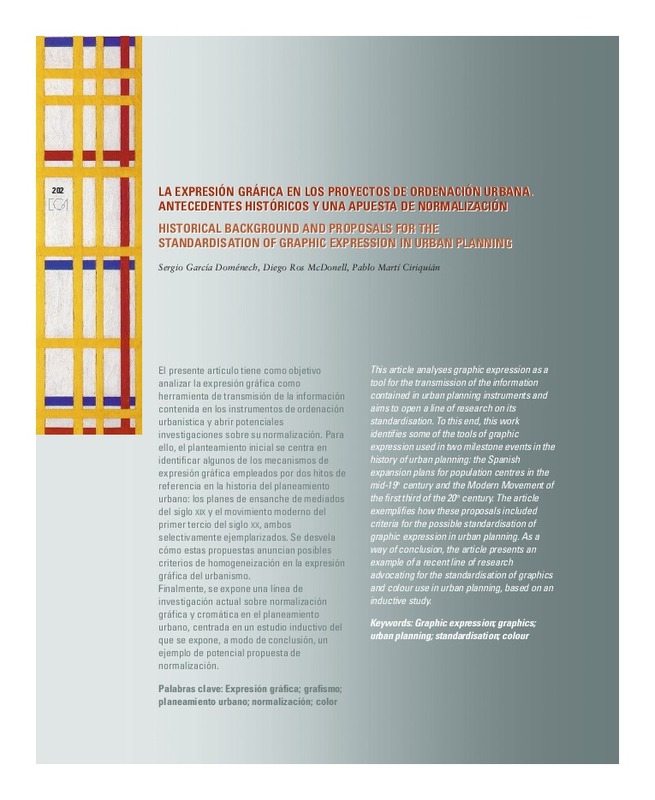JavaScript is disabled for your browser. Some features of this site may not work without it.
Buscar en RiuNet
Listar
Mi cuenta
Estadísticas
Ayuda RiuNet
Admin. UPV
LA EXPRESIÓN GRÁFICA EN LOS PROYECTOS DE ORDENACIÓN URBANA. ANTECEDENTES HISTÓRICOS Y UNA APUESTA DE NORMALIZACIÓN
Mostrar el registro sencillo del ítem
Ficheros en el ítem
| dc.contributor.author | Garcia Domenech, Sergio
|
es_ES |
| dc.contributor.author | Ros Mcdonnell, Diego
|
es_ES |
| dc.contributor.author | Martí Ciriquian, Pablo
|
es_ES |
| dc.date.accessioned | 2013-03-01T08:51:54Z | |
| dc.date.available | 2013-10-23T22:30:52Z | |
| dc.date.issued | 2012 | |
| dc.identifier.issn | 1133-6137 | |
| dc.identifier.uri | http://hdl.handle.net/10251/27415 | |
| dc.description.abstract | [EN] This article analyses graphic expression as a tool for the transmission of the information contained in urban planning instruments and aims to open a line of research on its standardisation. To this end, this work identifies some of the tools of graphic expression used in two milestone events in the history of urban planning: the Spanish expansion plans for population centres in the mid-19th century and the Modern Movement of the first third of the 20th century. The article exemplifies how these proposals included criteria for the possible standardisation of graphic expression in urban planning. As a way of conclusion, the article presents an example of a recent line of research advocating for the standardisation of graphics and colour use in urban planning, based on an inductive study. | es_ES |
| dc.description.abstract | [ES] El presente artículo tiene como objetivo analizar la expresión gráfica como herramienta de transmisión de la información contenida en los instrumentos de ordenación urbanística y abrir potenciales investigaciones sobre su normalización. Para ello, el planteamiento inicial se centra en identificar algunos de los mecanismos de expresión gráfica empleados por dos hitos de referencia en la historia del planeamiento urbano: los planes de ensanche de mediados del siglo XIX y el movimiento moderno del primer tercio del siglo XX, ambos selectivamente ejemplarizados. Se desvela cómo estas propuestas anuncian posibles criterios de homogeneización en la expresión gráfica del urbanismo. Finalmente, se expone una línea de investigación actual sobre normalización gráfica y cromática en el planeamiento urbano, centrada en un estudio inductivo del que se expone, a modo de conclusión, un ejemplo de potencial propuesta de normalización. | es_ES |
| dc.language | Español | es_ES |
| dc.language | Inglés | |
| dc.publisher | Editorial Universitat Politècnica de València | es_ES |
| dc.relation.ispartof | EGA. Revista de Expresión Gráfica Arquitectónica | |
| dc.rights | Reserva de todos los derechos | es_ES |
| dc.subject | Expresión gráfica | es_ES |
| dc.subject | Grafismo | es_ES |
| dc.subject | Planeamiento urbano | es_ES |
| dc.subject | Normalización | es_ES |
| dc.subject | Color | es_ES |
| dc.subject | Graphic expression | es_ES |
| dc.subject | Graphic | es_ES |
| dc.subject | Urban planning | es_ES |
| dc.subject | Standardisation | es_ES |
| dc.subject | Colour | es_ES |
| dc.title | LA EXPRESIÓN GRÁFICA EN LOS PROYECTOS DE ORDENACIÓN URBANA. ANTECEDENTES HISTÓRICOS Y UNA APUESTA DE NORMALIZACIÓN | es_ES |
| dc.title.alternative | HISTORICAL BACKGROUND AND PROPOSALS FOR THE STANDARDISATION OF GRAPHIC EXPRESSION IN URBAN PLANNING | es_ES |
| dc.type | Artículo | es_ES |
| dc.date.updated | 2013-02-15T13:01:36Z | |
| dc.identifier.doi | 10.4995/ega.2012.1442 | |
| dc.rights.accessRights | Abierto | es_ES |
| dc.description.bibliographicCitation | Garcia Domenech, S.; Ros Mcdonnell, D.; Martí Ciriquian, P. (2012). LA EXPRESIÓN GRÁFICA EN LOS PROYECTOS DE ORDENACIÓN URBANA. ANTECEDENTES HISTÓRICOS Y UNA APUESTA DE NORMALIZACIÓN. EGA. Revista de Expresión Gráfica Arquitectónica. 17(20):202-213. https://doi.org/10.4995/ega.2012.1442 | es_ES |
| dc.description.accrualMethod | SWORD | es_ES |
| dc.relation.publisherversion | https://doi.org/10.4995/ega.2012.1442 | es_ES |
| dc.description.upvformatpinicio | 202 | |
| dc.description.upvformatpfin | 213 | |
| dc.description.volume | 17 | |
| dc.description.issue | 20 | |
| dc.identifier.eissn | 2254-6103 |








